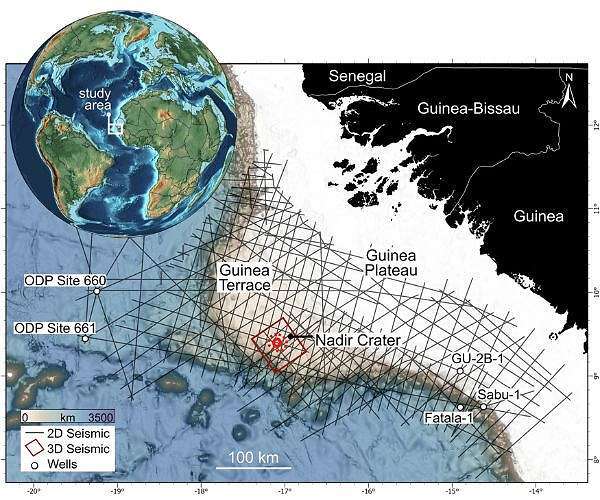8.10.2024

The MC3D seismic cube used for this study is highlighted in red, with the updated crater outline at the Top Cretaceous horizon defined from 3D (Fig. 2). Seismic data are shown above 15-arc second bathymetry data from GEBCO. The inset map shows the crater location on a paleogeographic reconstruction of the Central Atlantic at 66Ma. The reconstruction was made using GPlates.
Researchers from Heriot-Watt University have released new high-resolution images of the Nadir Crater, an asteroid impact site buried deep beneath the Atlantic Ocean. The crater, located about 300 meters below the seafloor, spans approximately 9 kilometers in width and was formed by an asteroid collision around 66 million years ago, at the end of the Cretaceous period.
The Nadir Crater, discovered in 2022 by Dr. Uisdean Nicholson, now joins the ranks of confirmed asteroid impacts from this period, similar in age to the Chicxulub impact crater in Mexico, which is associated with the mass extinction event that wiped out the dinosaurs. Using seismic data, researchers were able to reconstruct the chaotic minutes following the impact, including the formation of the crater, the flow of liquefied rocks, and an 800-meter tsunami that swept across the Atlantic.
Dr. Nicholson, who first identified the crater through seismic reflection data, worked with international geologists and planetary scientists to confirm that the crater was caused by an asteroid roughly 450-500 meters wide. He explained, "The detailed 3D seismic data provides an unprecedented view of the crater, allowing us to see it in all its layers, much like the difference between an old grainy ultrasound and modern 3D imaging."
The new data not only confirms the asteroid impact but also sheds light on the trajectory and speed of the object, which is believed to have struck Earth at about 72,000 kilometers per hour from the northeast. "We can now visualize the devastation caused by the impact, including landslides and seismic disturbances, as well as the massive tsunami that followed," Nicholson added.
The crater offers a unique opportunity for scientists to explore the processes of marine impact cratering. Collaborators such as Dr. Sean Gulick from the University of Texas and Dr. Veronica Bray from the University of Arizona emphasized the importance of these findings for understanding impact events on Earth and other planets. Dr. Bray noted, "This is an unprecedented look at a preserved impact crater, offering insights that we usually only get from craters on other planetary bodies."
Looking ahead, the team has applied for permission to drill into the seabed to recover core samples, which will help provide more detailed information about the impact's effects and the precise timeline of events. This research not only deepens our understanding of Earth's history but also serves as a reminder of the potential risks posed by near-Earth objects like asteroid Bennu, which has a small chance of impacting Earth in the coming centuries.
Quelle: SD
